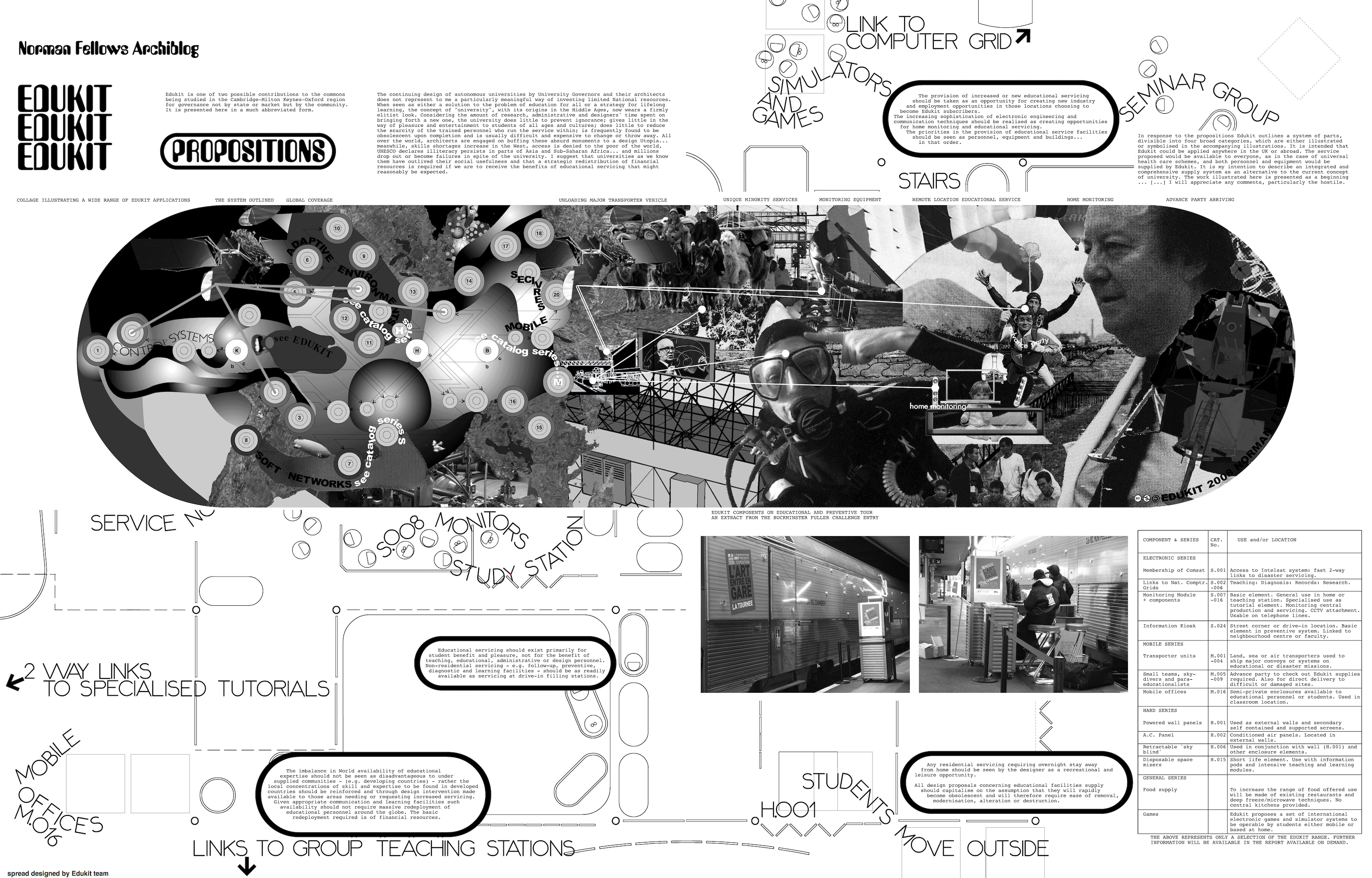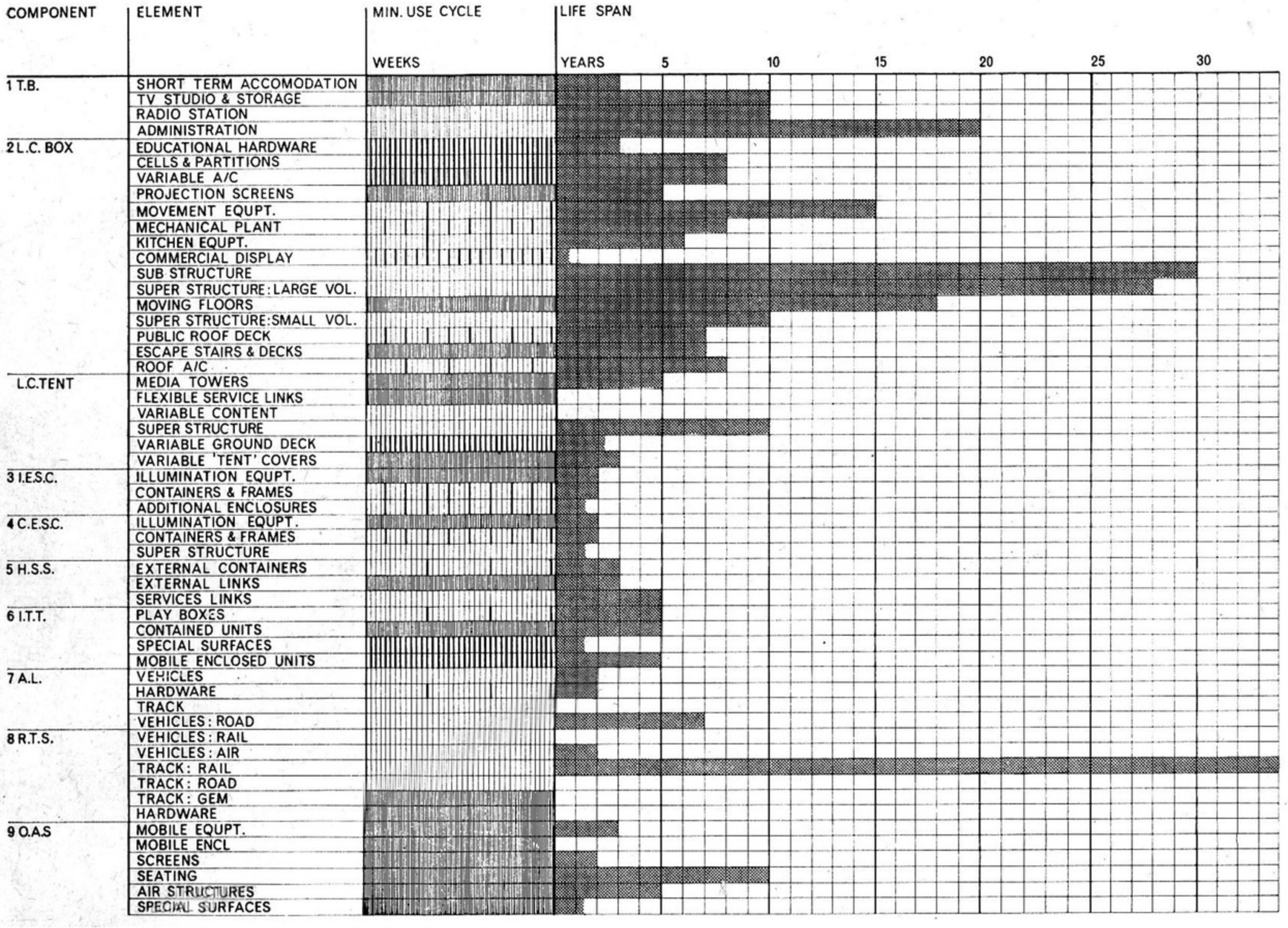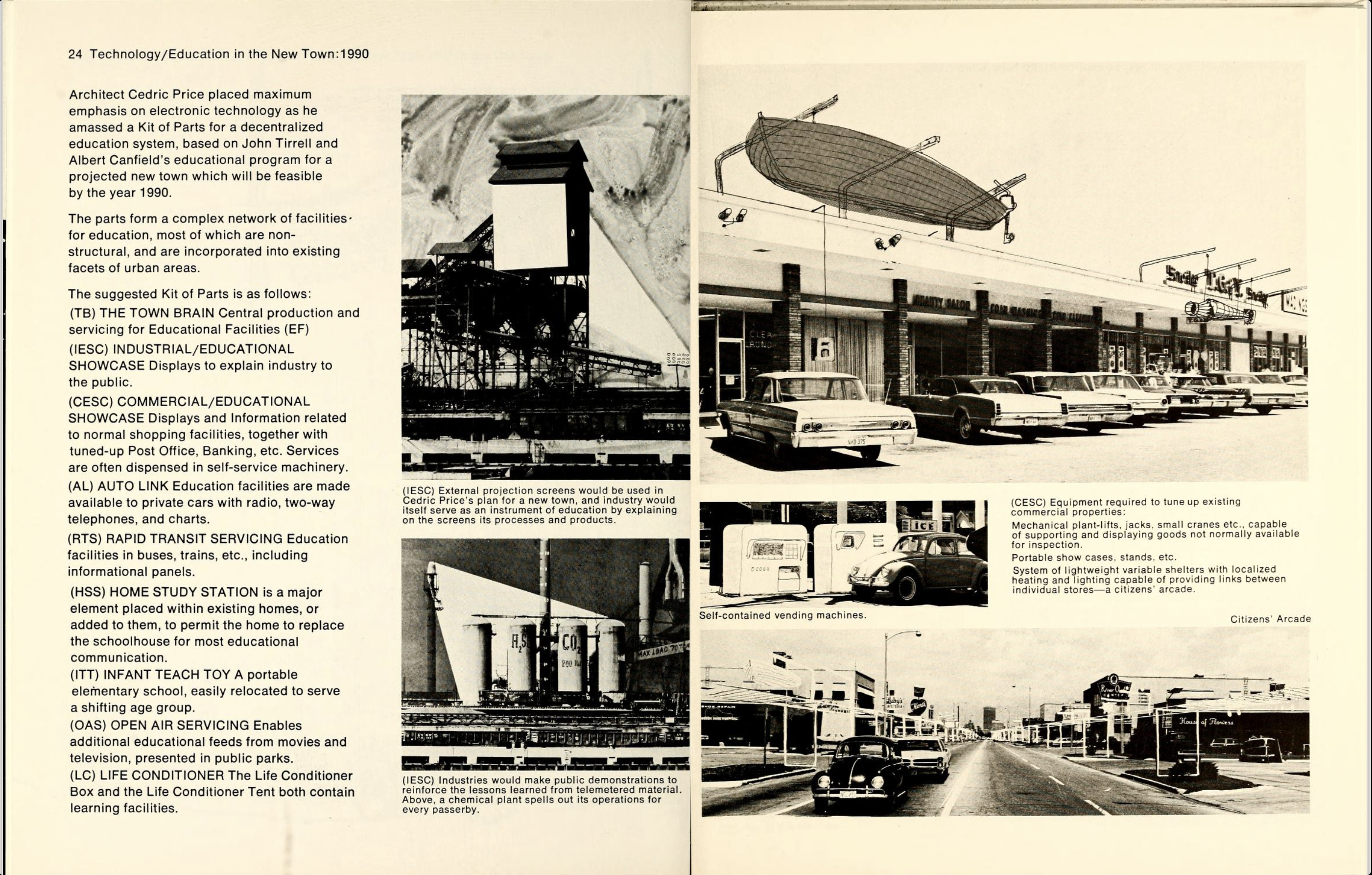EDUKIT: World Educational System
• World Map indicating the global imbalance in the provision of educational facilities in the existing system
- "You never change things by fighting the existing reality. To change something, build a new model that makes the existing model obsolete."
- (Buckminster Fuller)
[edit] Introduction
Designing Edukit was started by Norman Fellows in July 1996—having been anticipated by Potteries Thinkbelt (PTb) designed by Cedric Price in 1964 and ATOM: A generating system designed by Cedric Price in 1967. It was submitted to the Buckminster Fuller Challenge in March 2015 as an architectural response to a critical need, namely:—
- "help to build an egalitarian world educational system."
- (Norman Fellows, 2015)
In relation to being socially useful, its origins can be traced back to the PTb and to Atom US. For example:—
- "... the challenge from the Junior Government Minister, Lord Kennet, to explain an alternative to the then popular 'new' universities (early sixties) produced the Potteries Thinkbelt..."
- (Cedric Price, 1984)
and, from the design charrette which produced Atom US:—
- "Architect Cedric Price placed maximum emphasis on electronic technology as he amassed a Kit of Parts for a decentralized education system, based on John Tirrell and Albert Canfield's educational program for a projected new town which will be feasible by the year 1990."
- (William Cannady, 1970)
The rationality of the PTb and Atom US has been discussed in two related articles on Designing Buildings and is assumed.
In addition, the rationality of two more parts of an egalitarian world educational system - i.e. the Dukeries Thinkbelt (DTb) designed by Norman Fellows in 2014 and Atom UK designed by Norman Fellows in 2017 - has also been discussed in those two related articles and is therefore also assumed.
Thus the purpose of this article is to discuss the rationality of the proposed whole - i.e. 'Edukit' - as opposed to the rationality of the parts - i.e. 'Thinkbelts' and 'Atoms'. It begins with two categorical propositions, namely:—
- ... that 'Atoms' are linked to 'Edukit'; and
- ... that 'Thinkbelts' are linked to 'Atoms'.
[edit] CATEGORICAL PROPOSITION 1
The premise that Atoms are linked to Edukit raises the following questions in relation to being socially useful, namely:—
- 'Where?'
- 'When?'
- 'To whom?'
Tables 1 - 3 below provide brief answers.
|
Atom US was a design for an educational facility located in a projected new town called Atomia near the metropolitan area of Chicago in Illinois in the United States - see Fig.1 (top). Fig. 2. Cambridge-Milton Keynes: location map. Atom UK is a design for links between Cambridge and Milton Keynes near the metropolitan area of London in the UK - see Fig. 2 (right). |
Edukit has been described as:—
Fig. 1 (bottom) and Fig. 2 (left) indicate the respective locations of Atom US and Atom UK on the globe. In addition:— (1) William Cannady (1970) has described Atom US as:—
(2) Kathy Velikov (2015) has described it as:—
(3) Cedric Price (1969) has pointed to Atom US as a potential model for Atom UK:—
Furthermore:— (4) Arthur C. Clarke (1945) has anticipated the development of extra-terrestrial relay services and the role of geostationary satellites:—
Fig. 3. Three satellite stations would ensure complete coverage of the globe. These location maps demonstrate that Edukit is both spatially distributed and localized. |
• Table 1: Maps indicating 'where' Atoms and Edukit are linked.
|
Fig. 4. Graph of use cycle and lifespan, Atom US Atom US was designed in June 1967. William Canfield (1970) wrote that the kit of parts was:—
However, Cedric Price (1968) wrote:—
|
Edukit is a work "in progress" started in 1996. Fig. 4 charts all of the components that comprised Atom US, mapping out what Kathy Velikov (ib.) called:—
Thinking longer term, in an interview conducted by Norman Fellows in February 1993, Cedric Price said:—
Atom US was an early entry project in the field of education and over fifty years later it is emulated in Atom UK. These temporal considerations demonstrate that the element of time is a key criterion in the design of Edukit |
• Table 2: Time and timings indicating 'when' Atoms and Edukit are linked.
|
Atom US was subtitled "Design for new learning for a new town"
Fig. 5. Diagrammatic plan of Atomia Atom UK began as a spin off from Atom US, namely:—
- see Fig. 6 right. Initially, its "loose links" are intended to serve the communities between Cambridge and Milton Keynes, including Bedford, before eventually hooking up with Oxford to create a new institution, namely:—
- see Fig. 7 right. |
"Edukit is one of two possible contributions to the commons being created in the Cambridge-Milton Keynes-Oxford region for governance not by state or market but by the community."
Fig. 6. Diagrammatic plan of C-MK Fig. 7. Diagrammatic plan of redefined CAMKOX area These diagrammatic plans demonstrate that Edukit contributes to the commons as a social good (cf. the NHS). |
• Table 3: Diagrammatic plans indicating populations 'to whom' Atoms and Edukit are linked.
However, the premise that Atoms are linked to Edukit also raises a particular challenge for the designer, namely:—
4. 'How?'
Table 4 below provides a detailed answer.
|
Fig. 8. 'Atom facsimiles' - click to see Full resolutions Atom US was originally published in the May 1968 issue of Architectural Design in which Guest editor Cedric Price concluded:— |
Fig. 9. 'Edukit images' - click to see Full resolutions These textual records demonstrate :—
|
• Table 4: Textual records indicating 'how' Atoms and Edukit are linked.
Thus this article provides sufficient evidence to support its major premise, namely:—
- ... that 'Atoms' are linked to 'Edukit'.
[edit] CATEGORICAL PROPOSITION 2
The premise that Thinkbelts are linked to Atoms also raises the same questions in relation to being socially useful, namely:—
- 'Where?'
- 'When?'
- 'To whom?'
Tables 5 - 7 below provide brief answers.
|
Thinkbelts are both located in the Midlands of England.
The PTb is located in the West Midlands. In New Society (1966) Cedric Price asked:—
However, Cedric Price also suggested a follow-up:—
The DTb is located in the East Midlands. |
Atom US is located at what Buckminster Fuller called:—
Cedric Price suggested another follow-up:—
Fig. 12. Site map - sub-regional context of Atom UK Fig. 13. Map of Europe indicating megalopolises These maps, including Figs. 1, 2 and 3, demonstrate that Thinkbelts and Atoms are linked both spatially and locally. |
• Table 5: Maps indicating 'where' Thinkbelts and Atoms are linked.
|
Fig. 14. Chart of life span and use cycle, PTb (1964) Fig. 15. Chart of life span and use cycle, DTb (2014) |
Fig. 16. Graph of use cycle and lifespan, Atom UK - see Fig. 4 above in Table 2. The charts in Fig. 14 and Fig. 15 demonstrate that Thinkbelts postulated various means of exchange, namely:—
The graphs in Fig. 4 and Fig. 16 demonstrate that Atoms use the same means of exchange. These Figures demonstrate that Thinkbelts and Atoms are linked by the element of time as a design criterion. |
• Table 6: Time and timings indicating 'when' Thinkbelts and Atoms are linked.
|
Thinkbelt study - work "in progress" Fig. 18. Pull quote from PTb article, AD 10/66 Fig. 19. Diagram indicating regional context of DTb Cedric Price asked in 2003 'what is the value of it now - what is useful about it now, for you?' |
Atom study - work "in progress" Fig. 18. National + Regional Conditions of Atom UK Fig. 19. Map indicating possible extension of CAMKOX These maps demonstrate that Thinkbelts and Atoms are socially useful beyond their immediate contexts. |
• Table 7: Diagrammatic plans indicating populations 'to whom' Thinkbelts and Atoms are linked.
However, the premise that Atoms are linked to Edukit raises another challenge for the designer, namely:—
4. 'How?'
Table 8 below provides a detailed answer.
|
Fig. 20. 'The Potteries Thinkbelt Study 1964' Fig. 21. 'The Dukeries Thinkbelt Study 2015' |
The Atom US Study by William Cannady
These textual records demonstrate the possibility that Thinkbelts and Atoms might generate new cities. |
• Table 8: Textual records indicating 'how' Thinkbelts and Atoms are linked.
Thus this article provides evidence to support its minor premise, namely:—
- ... that 'Thinkbelts' are linked to 'Atoms'.
[edit] CONCLUSION
This article affirms its premises, namely:—
- ... that 'Atoms' are linked to 'Edukit'; and
- ... that 'Thinkbelts' are linked to 'Atoms'.
The conclusion therefore is:—
- ... that 'Thinkbelts' are linked to 'Edukit'.
After Edukit, what would be next? A Global Thinkbelt?
[edit] Appendix 1: EDUKIT
- "Edukit is one of two possible contributions to the commons being created in the Cambridge-Milton Keynes-Oxford region for governance not by state or market but by the community."
- (Norman Fellows, AD 10/19)

|
• 'Edukit spread' designed by Norman Fellows
nb The project gives due acknowledgement to the original conception.
- "...if the state wished to discuss the total process of education for all its high schools in relation to nursery schooling on the one hand and to university education on the other, then a new metasystem logically beyond the first metasystem would be required. And in this case the question whether the second metasystem is not only logically but also constitutionally superior would arise. It would be discussed in those familiar terms about autonomy, about professional integrity, about bureaucratic interference, about synergy ... Such discussions would be less boring if we could get the logic right first."
- (Stafford Beer, 1970)
[edit] Appendix 2: Preamble to Edukit
|
"The continuing design of autonomous universities by University Governors and their architects does not represent to me a particularly meaningful way of investing limited National resources. When seen as either a solution to the problem of education for all or a strategy for lifelong learning, the concept of "university", with its origins in the Middle Ages, now wears a firmly elitist look. Considering the amount of research, administrative and designers' time spent on bringing forth a new one, the university does little to prevent ignorance; gives little in the way of pleasure to students of all ages and cultures; does little to reduce the scarcity of the trained personnel who run the service within; is frequently found to be obsolescent upon completion and is usually difficult and expensive to throw away. All over the world, architects are engaged on buffing these absurd monuments to a design Utopia... meanwhile, skills shortages increase in the West, access is denied to the poor of the world, UNESCO declares illiteracy persists in parts of Asia and Sub-Saharan Africa... and millions drop out or become failures in spite of the university. I suggest that universities as we know them have outlived their social usefulness and that a strategic redistribution of financial resources is required if we are to receive the benefits of educational servicing that might reasonably be expected." (Norman Fellows, 2019) |
[edit] Appendix 3: EDUKIT PROPOSITIONS
|
|
[edit] Appendix 4: EDUKIT CATALOGUE
|
• Panel: 'Presenting Edukit catalogue' designed by Norman Fellows
[edit] Appendix 5: SOFT SERIES & COMPONENTS |
|
Membership of Comsat Access to Intelsat system: fast 2-way links to disaster servicing. |
|
Links to National Computer Grid Teaching : Diagnosis : Records : Research
|
|
Monitoring Module + components Basic element. General use in home or teaching station. Specialised use as tutorial element. Monitoring central production and servicing. CCTV attachment. Usable on telephone lines. |
|
Street corner or drive-in location. Basic element in preventive system. Linked to neighbourhood centre or faculty. |
Learn More |
[edit] Appendix 6: MOBILE SERIES & COMPONENTS |
|
Transporter units Land, sea or air transporters used to ship major convoys or systems on educational or disaster missions. |
Learn More |
|
Small teams, sky-divers and para-educationalists Advance party to check out Edukit supplies required. Also for direct delivery to difficult or damaged sites. |

|
|
Mobile offices Semi-private enclosures available to educational personnel or students. Used in classroom location. |

|
[edit] Appendix 7: HARD SERIES & COMPONENTS |
| Powered wall panels | 
|
| A.C. Panel | 
|
| Retractable 'sky blind' | 
|
| Disposable space mixers | 
|
[edit] Appendix 8: GENERAL SERIES & COMPONENTS |
| Food supply | 
|
|
Games Edukit proposes a set of international electronic games and simulator systems to be operable by students either mobile or based at home. |

|
[edit] Notes
See World Map indicating the global imbalance in the provision of educational facilities in the existing system.
- Gaba, E. (2009) 'Fuller projection rotated.svg', Wikipedia.
- GENI (2013) 'Global Electric Energy Grid'.
- THE (2013) 'World University Rankings 2012-13', Times Higher Education.
- "A University need not be conceived as a set of buildings around a courtyard with living accommodation and a lecture theatre. The educational system might, in certain circumstances, be spatially distributed rather than localized. In any case, architects are positively encouraged to anticipate trends such as the development of educational technology and to provide for their impact upon whatever structure is erected. By token of this the architect quite often comes into the picture at the time when a higher educational system is being contemplated, without commitment to whether or not it is called a university."
- (Gordon Pask, AD 9/69)
[edit] Further Reading
Alexander, C. (1968) 'Systems Generating Systems', Architectural Design, December, pp. 605-610, on extremelyprovocative.
Clarke, A.C. (1945) 'Extra-terrestrial Relays', Wireless World, October.
Fellows, N. (1993) ‘Transcript – Interview of Cedric Price’, Archiblog on Google Drive.
Fellows, N. (1996) 'Transcript: Interview of Cedric Price (Extract 1)', Archiblog on Google Drive.
Fellows, N. (2015) ''The Fuller Challenge: My First Submission', Beyond Supercrit #1: CP: PTb, Blogger.
Fellows, N. (2016) 'Potteries Thinkbelt by Cedric Price', Blogger.
Fellows, N. (2016) 'Dukeries Thinkbelt', New Society, 2 June, WordPress.
Fellows, N. (2016) 'Dukeries Thinkbelt', Anticipatory Design, October, WordPress.
Fellows, N. (2019) 'Edukit: A fantasia of the stories behind it', DreamHost.
Fellows, N. (2019) 'Edukit', Anticipatory Design, October.
Fellows, N. (2020) 'Edukit: World Educational System', WordPress.
Fellows, N. (2020) 'CAMKOX', WordPress.
Fellows, N. (2020) 'Oxbridge Community College', WordPress.
Fellows, N. (2020) 'Edukit: World Educational System—Kit of Parts', DreamHost.
Fellows, N. (2020) 'Dukeries Thinkbelt', Vimeo.
Fellows, N. (2020) 'The Thinkbelt Now', Thinkbelt, Wordpress.
Fuller, R. B. (1962) 'Education Automation', Southern Illinois University Press.
Pask, G. (1969) 'The Architectural Relevance of Cybernetic, Architectural Design, September.
Price, C. (1966) 'Potteries Thinkbelt', New Society, 2 June, on Wordpress.
Price, C. (1966) 'Potteries Thinkbelt', October, Architectural Design, on Wordpress.
Price, C. et al. (1969) 'Non-Plan', 21 March, New Society.
Price, C. (1969) 'Non-Plan', Architectural Design, May.
Price, C. (1968) 'Atom: Design for New Learning for a New Town', Architectural Design, May, pp.232-235.
Price, C. (1984) 'Cedric Price: Works II', Architectural Association.
Tirrell, J.E. and Canfield, A.A. (1968) 'Goodbye to the Classroom', Architectural Design, May.
Velikov, K. (2015) 'Tuning Up the City - Cedric Price's Detroit Think Grid', ResearchGate.
Wikipedia (2023) 'Categorical proposition', Wikipedia.
Wikipedia (2023) 'Syllogism', Wikipedia.
[edit] Websites
- https://archinect.com/archiblog/project/edukit
- https://edukit.wordpress.com/
- https://edukit.anticipatorydesign.info/
- https://www.edukit.org/
Signature--Archiblog 16:56, 10 May 2023 (BST)
[edit] Related articles on Designing Buildings
- • Potteries Thinkbelt
- • Potteries Thinkbelt study
- • ATOM: A generating system designed by Cedric Price
Featured articles and news
ECA Blueprint for Electrification
The 'mosaic of interconnected challenges' and how to deliver the UK’s Transition to Clean Power.
Grenfell Tower Principal Contractor Award notice
Tower repair and maintenance contractor announced as demolition contractor.
Passivhaus social homes benefit from heat pump service
Sixteen new homes designed and built to achieve Passivhaus constructed in Dumfries & Galloway.
CABE Publishes Results of 2025 Building Control Survey
Concern over lack of understanding of how roles have changed since the introduction of the BSA 2022.
British Architectural Sculpture 1851-1951
A rich heritage of decorative and figurative sculpture. Book review.
A programme to tackle the lack of diversity.
Independent Building Control review panel
Five members of the newly established, Grenfell Tower Inquiry recommended, panel appointed.
Welsh Recharging Electrical Skills Charter progresses
ECA progressing on the ‘asks’ of the Recharging Electrical Skills Charter at the Senedd in Wales.
A brief history from 1890s to 2020s.
CIOB and CORBON combine forces
To elevate professional standards in Nigeria’s construction industry.
Amendment to the GB Energy Bill welcomed by ECA
Move prevents nationally-owned energy company from investing in solar panels produced by modern slavery.
Gregor Harvie argues that AI is state-sanctioned theft of IP.
Heat pumps, vehicle chargers and heating appliances must be sold with smart functionality.
Experimental AI housing target help for councils
Experimental AI could help councils meet housing targets by digitising records.
New-style degrees set for reformed ARB accreditation
Following the ARB Tomorrow's Architects competency outcomes for Architects.
BSRIA Occupant Wellbeing survey BOW
Occupant satisfaction and wellbeing tool inc. physical environment, indoor facilities, functionality and accessibility.




























































